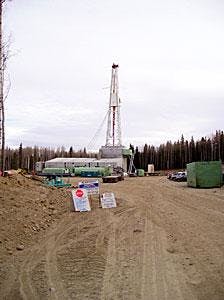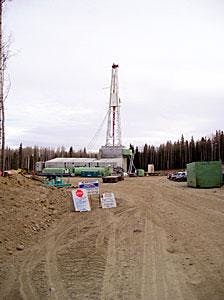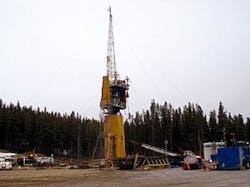Canadian Natural Resources Ltd. controlled losses and a significant H2S kick in a deep well using a new dual-action lost-circulation material. CNRL experienced severe losses while drilling through a high-pressure, deep gas pay zone in the foothills of west-central Alberta. Reducing the drilling-fluid density slowed the rate of losses; however, the decrease in hydrostatic pressure led to a gas influx from the same formation.
Conditions were further complicated by the presence of H2S in dangerous concentrations. Several types of commonly used lost-circulation material (LCM) were pumped downhole in an attempt to control the losses.
As an alternative to commonly used LCM, the operator decided to try the recently developed Hydro-plug lost circulation material. This is a dual-action LCM that contains multiple-sized particles to enhance fracture tip screenout, along with a synthetic polymer that hydrates in water. When mixed with fresh water and spotted downhole, the polymer can swell up to 400 times its original size. The LCM expands while held under low squeeze pressure.
The drilling fluid used by CNRL was a water-based mud mixed with xanthan gum for viscosity and included a specialized polymer thinner designed to deflocculate clays under high-temperature conditions. The mud density was greater than 18 ppg and provided good suspension and fluid-loss control while carrying up to 40% solids from weighting material.
The objective of the well was gas production from the Devonian Wabamun formation, a dolomite with a very low porosity and very low permeability. Gas is often found in a fracture system typically no wider than 2.5-3 ft but extending out as far as 3-5 miles from a wellbore.
The estimated bottomhole pressure for the well was 13,020-13,800 psi with bottomhole temperatures as high as 370° F., based on observations in direct offset wells. The spread from wells in the vicinity, however, showed that bottomhole pressures could be as low as 12,161 psi. These challenging wells exhibit a very narrow margin between pore pressure and fracture gradient.
Precision Drilling Corp.'s rig No. 425 works at TDE-CNRL Tower Creek well (Fig. 1, courtesy of Canadian Natural Resources Ltd.).
The formation was penetrated at about 15,000 ft with an initial mud weight of 18.52 ppg, including a 200-psi trip margin. After drilling into the Wabamun formation, CNRL experienced a 40-bbl/hr mud-loss rate. Slowing the pump rate and dropping the density to 17.52 ppg reduced the loss rate to 20 bbl/hr.
Drilling fluid personnel used Baroid's DFG drilling fluids graphics hydraulics modeling software to determine the equivalent circulating density (ECD) and to optimize the mud's rheological and density properties in order to maintain better control of downhole pressures. After the mud weight was lowered to 16.94 ppg, the losses stopped, but the well had a slight flow under static conditions.
The well was then shut in and no pressures were evident. When the well was opened, the hole appeared static. Upon circulating one "bottoms up," however, there was a significant influx and gas concentration soared to more than 8,800 units.
The well was immediately shut in with an initial shut in casing pressure (SICP) of 4,000 psi and shut in drill pipe pressure (SIDPP) of 715 psi. The mud weight was increased to 17.02 ppg. Within 2 hr the SICP increased to 8,600 psi, while the SIDPP increased to 1,150 psi. The H2S monitor on surface showed 400 ppm H2S and the crews immediately followed emergency response H2S procedures.
After 43 hr of well control with the "weight and wait" method, the kick was circulated out and the mud density stabilized at 17.18 ppg. No gas came in while circulating, but the well would flow if the mud pumps were stopped and the well was brought to static conditions.
The hole was losing mud at the rate of 24 bbl/hr. DFG hydraulics modeling indicated that the density needed to balance the pressure under static conditions was 17.52 ppg (not including a trip margin), but increasing the density led to more rapid losses.
Several different conventional lost-circulation pills were spotted across the fracture, but these failed to reduce the loss rate, preventing the resumption of safe drilling operations. The operator considered three options:
1. Set a hematite cement plug to overcome the gas pressure but risk irreparable damage to the pay zone and/or risk the potential for an unwanted sidetrack due to the high compressive strength of the cement plug.
2. Set a plug that would allow the operator safely to move the drilling rig off location (given the H2S threat) and allow room to bring in a 15,000-psi snubbing unit with a 69-ft substructure and reconfigure the rig to accommodate this height.
3. Pump a pill made with the recently developed hydrating LCM, followed by a barite plug.
More radical treatments involving other polymer or gunk squeeze plugs were considered but would have required extra lines to the wellhead, additional pumping equipment, a possible bit trip to change out or remove nozzles (or the bit itself), and greater exposure to risk of human error.
Two different volumes and two different pumping times would have to be calculated and coordinated. Finally, had a trip been necessary, it could not have been safely performed without a stand-alone snubbing unit.
CNRL selected Option 3.
A little more than 40 sacks of Baroid's hydrating LCM were mixed with 25 bbl of fresh water, weighted to 17.2 ppg, and then pumped through the bit. Normally the rig pump would have been used for this, but due to continuous mud mixing to replace lost volumes, CNRL decided to use a cementing unit to mix and spot the hydratable pill. The cementing unit was used to help ensure accurate density and volumetric control of the hydratable pill while mixing and pumping.
Three consecutive pills were spotted, each reducing the loss rate significantly until full returns were restored, thus allowing CNRL to set a barite plug and successfully run and cement the production liner.
When the first pill was spotted across the fracture, the crew held it under a backpressure of 290 psi for 2 hr with a closed choke. No losses occurred after breaking circulation. When drilling was resumed, the well began to lose fluid again, but at a manageable rate of 12 bbl/hr.
After spotting a second 15.7-bbl pill and holding 750-psi backpressure for 2 hr, CNRL resumed circulation and no losses occurred. As the mud weight reached the 17.52-ppg target density, however, as determined by the hydraulics modeling software, the well began to lose mud at a rate of 6-8 bbl/hr.
A third 31.4-bbl pill was spotted and it held almost 1,500-psi backpressure through the choke. Finally a 10-bbl barite plug was placed immediately above it to prevent further influxes.
A total 72 hr had elapsed since the decision to mix and pump the first hydratable pill. The barite plug was allowed to settle for 48 hr. The wellbore proved able to tolerate an ECD of 19.15 ppg, which was the ECD predicted by hydraulics modeling for running and cementing the liner.
High Arctic Well Control Inc.'s standalone snubbing unit can handle up to 15,000 psi (Fig. 2, courtesy of Canadian Natural Resources Ltd.).
After numerous wiper trips and complete wellbore circulations, the well was classified stable enough to tolerate the surge and swab pressures induced by running the liner into the wellbore. The running speed of the liner was modeled and optimized to minimize surge pressure experienced at the fracture.
The running speed was carefully monitored as determined by the surge model. The liner was run successfully to the top of the fracture and successfully cemented with full mud returns during cementing operations.
Throughout the lost-circulation and well-control events, the Baroid technical support team in Calgary was in constant communication with Halliburton professionals worldwide via the Baroid knowledge management (KM) portal on the intranet. About 30 responses came in during the first 12 hr of well-control operations. The loss of the well was definitely a consideration and possibility, but the potential for loss of life, equipment, and the environment was a far greater problem.
The KM responses prompted drilling fluid personnel to reverify ECDs through the modeling software so they could aim for the appropriate mud density after the losses were cured. The KM network also helped facilitate a conference call between Baroid Canada and Baroid's lost-circulation and wellbore stability experts, who had experience with the hydrating LCM. The ability to obtain that knowledge in a quick and orderly fashion was crucial to CNRL's decisions.
Protecting the pay zone was a major concern for CNRL. When lost circulation occurs in the pay zone, resulting formation damage caused by fluid invasion can impair production. Spotting LCM can make matters worse unless the material is acid-soluble.
Therefore, the selection of materials available for sealing off pay zone losses with minimal damage is limited. In this case, however, the operator believed that a remedial acid job would penetrate beyond the barite plug and the LCM pill and with a good draw down the well would be productive.
The well was being completed as this article was going to press; preliminary results indicate that very little formation damage has occurred.
The authors
Barry Hucik ([email protected]) is a drilling superintendent for Canadian Natural Resources Ltd. in Calgary. He has more than 25 years' drilling experience in the Western Canada Sedimentary Basin. After 15 years as a wellsite supervisor, Hucik worked as a drilling superintendent for Cabre Exploration Ltd. and Rio Alto Exploration Ltd. in Calgary. He holds a CET degree (Certified Engineering Technology) from the Southern Alberta Institute of Technology (SAIT) in Calgary. He is a member of the Alberta Society of Engineering Technologists (ASET).
Alistair Brockie is a team leader with BP PLC for the Black Sea region based in Ankara, Turkey. He was a drilling superintendent with Canadian Natural Resources Ltd. in the winter of 2003. Brockie has more than 20 years' experience in the oilfield, predominantly in the North Sea and offshore Angola with Shell and BP PLC. In Angola, he was drilling superintendent for BP on the Block 18 Plutonio project. Brockie holds a BSc in petroleum engineering from the Robert Gordon University, Aberdeen.
Ryan Scammell ([email protected]) is a drilling engineer with Canadian Natural Resources Ltd. for the winter drilling season 2003-04, with 5 years' experience in the oil and gas industry. Prior to joining CNRL, Scammell worked as a technical professional with NOWSCO Well Services and BJ Services Co. Canada in cementing and well stimulation services. He holds a BSc in geological engineering from the University of Saskatchewan and is a member of the SPE and APEGGA (Association of Professional Engineers, Geologists, & Geophysicists of Alberta).
Gregg Lapinskie ([email protected]) is a senior technical professional in drilling fluids with Baroid/Halliburton Canada from 1998 to the present. He has more than 10 years' experience in the oil and gas industry, predominantly in the Foothills/Rocky Mountains of the Western Canada Sedimentary Basin, and has been recently involved with HPHT drilling in the foothills. He has also worked in the South China Sea off Malaysia and Brunei Darussalam.




